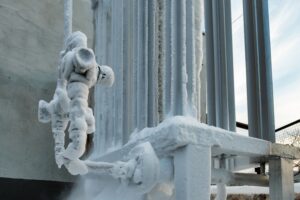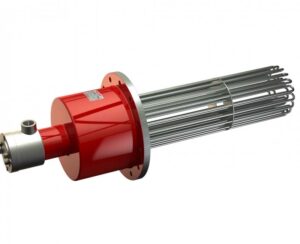Heat Trace Versus Immersion Heating
Last updated on August 18th, 2023 at 04:42 pm
 When it comes to heating systems, not every project will benefit from the same method. Considering applications, implications, environments, materials, budgets, and more, there are certain times to use heat trace and certain times to use immersion heating. Heat trace might not be as well-known as immersion heaters, so this article will break down heat trace and how it differs from immersion heating. For industrial operators, use this to find out which heating method is right for your project.
When it comes to heating systems, not every project will benefit from the same method. Considering applications, implications, environments, materials, budgets, and more, there are certain times to use heat trace and certain times to use immersion heating. Heat trace might not be as well-known as immersion heaters, so this article will break down heat trace and how it differs from immersion heating. For industrial operators, use this to find out which heating method is right for your project.
Defining heat trace
Heat trace cables are often used to combat freezing temperatures. In cold climates or seasons, businesses will use heat trace cables to maintain a temperature in pipes and valves so they don’t burst, malfunction, or ruin the contents being transferred.
Heat trace systems are developed by connecting special cables with resistance to the pipe. The electric cables provide heat where heat loss is possible. They’re connected to voltages that help convert energy into heat. Two copper cables run parallel to the heat trace cables which create the heating zone.
Heat trace systems with mineral-insulated (MI) cables can reach temperatures of close to 1000°F. Constant wattage cables normally sustain a temperature of 400°F and self-regulating cables range from 150°F to 400°F. While the purpose of heat trace systems is to prevent pipelines from freezing and bursting as the liquid expands, environments with consistently freezing temperatures won’t do as well using this method.
Constant versus self-regulating heat trace systems
Heat trace systems can be self-regulated or powered by constant wattage. A constant wattage system provides consistent, unchanging heat throughout the pipeline no matter the surrounding temperature. Whatever the circumstances, this method of heat trace will stay at one temperature. Constant wattage systems can’t overlap themselves or it will create hot spots and malfunction.
On the other hand, self-regulating systems take other temperatures into consideration. Heat output will change based on the temperature of the surface where the heat trace was installed. If it senses a hotter temperature, it will reduce the wattage output, and the opposite if it senses cooler temperatures.
How can it do this? The carbon polymer that conductive core of the cable responds to changes in temperature. In colder temperatures, the core contracts, increasing the number of electrical paths, and increasing the temperature. In warmer temperatures, the core expands, decreasing the electrical paths and lowering the temperature. Lastly, unlike constant wattage systems, self-regulating cables can overlap since they can sense temperature changes and adapt accordingly.
Applications
Generally, any industry that needs to keep pipelines from freezing and bursting can benefit from heat trace systems. The oil and gas industry is one of the most important sectors since a pause or shutdown in production affects the entire economy. The wrong temperature has negative impacts on money, profit and loss, business growth, and reputation.
For manufacturers, heat trace systems are crucial to keep factories running without cables, pipes, or equipment freezing. This industry is constantly supplying demand to make millions of products. Waiting for a pipeline to thaw isn’t an option.
In the agriculture industry, heat trace cables are used to keep tanks and equipment functioning in any weather conditions. Crops and livestock can be severely affected by a change or halt in this system which can lead to lots of waste.
Industries that work with delicate materials, chemicals, or resources that must be kept at specific conditions will also use heat trace cables to ensure the right temperature and viscosity are maintained.
Implications
Heat trace systems come with positives and negatives. On the plus side, they can be implemented in dangerous situations using self-regulated cables to ensure the right temperature is maintained. While heat trace cables are efficient enough on their own, they can be improved by adding insulation. This is especially helpful in colder climates to counteract the weather.
It’s possible to get savings by using heat trace systems. Get ahead of fixing pipelines by using heated cables. This will help save money that would be lost when temperatures drop. It has a longer lifespan and less upkeep than steam tracing and hot water tracing making it a more affordable option.
If heating portions of a pipeline is the goal, then heat trace is the solution. It’s more energy efficient than other methods if that’s the need since it will focus its heat on one part and not a whole pipeline system. However, if a whole system has to be heated, heat trace isn’t the right choice.
Heat trace is easy to install and manage. It can be installed in difficult locations and shapes;
not all heating systems are this flexible. However, it’s not an option for large tanks. It’s an external heating solution so it won’t succeed in heating a large body of liquid from the outside. An immersion heater would be a better solution.
Defining immersion heating
 Immersion heaters can come in multiple variations. There are flanged heaters, screw plug heaters, circulation heaters, over-the-side heaters, and inline heaters. On top of that, there are plenty of other heating options depending on the circumstances.
Immersion heaters can come in multiple variations. There are flanged heaters, screw plug heaters, circulation heaters, over-the-side heaters, and inline heaters. On top of that, there are plenty of other heating options depending on the circumstances.
Immersion heaters are much more effective in heating large amounts of materials in larger systems. Not only do they maintain temperatures, but they provide heat-up capabilities as well. For tanks, immersion heaters are a great option. For the customizability of a heat trace and the ability to heat up a liquid, tubular heaters are the way to go as they can be manufactured based on the needs of the industrial operator. To heat large amounts of liquid where viscosity is a concern, use circulation heaters.
Since immersion heaters are in contact with the liquids, gases, and oils they’re heating, special attention must be paid to chemical composition and metals. Some metals will break down in constant contact with certain chemicals. Some chemicals might react in ways they aren’t intended to when the wrong materials are used.
Heat trace systems work for select circumstances as an external method of maintaining heat within smaller spaces. For larger projects, chemical concerns, metals, and viscosity, immersion heaters are more helpful. At Wattco, they’re offered in various forms and can be custom manufactured. Check us out now or read some informative articles for more information.
